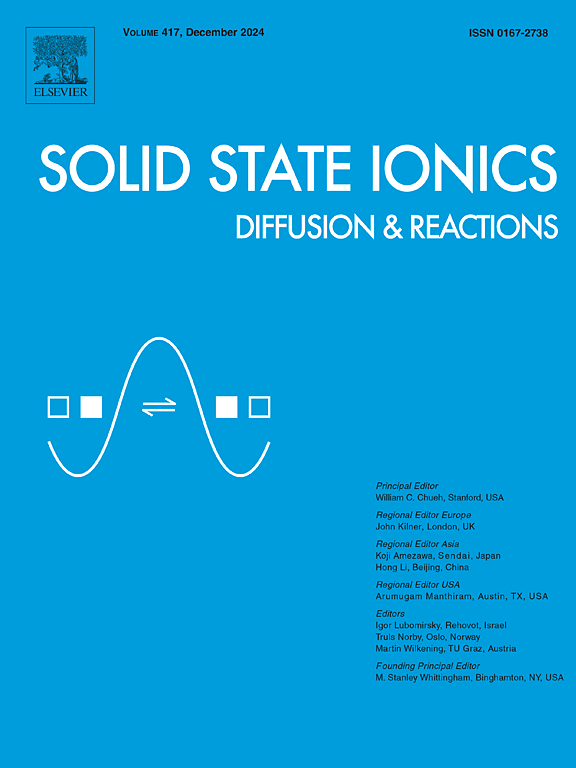Electrochemical properties and application of Bi-doped Ba3Ca1.18Nb1.82−xBixO9−δ electrolyte
IF 3
4区 材料科学
Q3 CHEMISTRY, PHYSICAL
引用次数: 0
Abstract
Ba3Ca1.18Nb1.82−xBixO9-δ (x = 0, 0.1, 0.2, 0.3) proton conductor materials with different Bi doping ratios are prepared. The Bi element was successfully doped into the lattice of Ba3Ca1.18Nb1.82−xBixO9−δ proton conductor to form a single perovskite phase. The effects of Bi doping on grain boundary are evaluated by the analysis of relaxation time distribution (DRT). The proper Bi doping ratio for Ba3Ca1.18Nb1.82−xBixO9−δ (x = 0, 0.1, 0.2, 0.3) can improves the grain boundaries performance. With the increase of Bi doping ratio, the conductivity of the sample increases first and then decreases. Among all the samples, Ba3Ca1.18Nb1.72Bi0.1O9-δ (BCNB10) has the highest conductivity and satisfactory proton transport properties. In the wet air atmosphere at 700 °C, the proton transference number of BCNB10 is still higher than 0.6. The Ba3Ca1.18Nb1.72Bi0.1O9-δ-based fuel cell has a power density of 59.7 mW cm2 at 700 °C. The results show that BCNB10 is a promising fuel cell electrolyte material with high performance.
双掺杂Ba3Ca1.18Nb1.82−xBixO9−δ电解质的电化学性能及应用
制备了不同铋掺杂比例的Ba3Ca1.18Nb1.82−xBixO9-δ (x = 0,0.1, 0.2, 0.3)质子导体材料。将Bi元素成功地掺杂到Ba3Ca1.18Nb1.82−xBixO9−δ质子导体的晶格中,形成单一的钙钛矿相。通过弛豫时间分布(DRT)分析,评价了铋掺杂对晶界的影响。在Ba3Ca1.18Nb1.82−xBixO9−δ (x = 0,0.1, 0.2, 0.3)中适当的Bi掺杂比例可以改善晶界性能。随着Bi掺杂比的增加,样品的电导率先增大后减小。在所有样品中,ba3ca1.18 nb1.72 bi0.10 -δ (BCNB10)具有最高的电导率和满意的质子输运性能。在700℃的湿空气气氛中,BCNB10的质子转移数仍高于0.6。在700℃时,ba3ca1.18 nb1.72 bi0.109 -δ基燃料电池的功率密度为59.7 mW cm2。结果表明,BCNB10是一种很有前途的高性能燃料电池电解质材料。
本文章由计算机程序翻译,如有差异,请以英文原文为准。
求助全文
约1分钟内获得全文
求助全文
来源期刊

Solid State Ionics
物理-物理:凝聚态物理
CiteScore
6.10
自引率
3.10%
发文量
152
审稿时长
58 days
期刊介绍:
This interdisciplinary journal is devoted to the physics, chemistry and materials science of diffusion, mass transport, and reactivity of solids. The major part of each issue is devoted to articles on:
(i) physics and chemistry of defects in solids;
(ii) reactions in and on solids, e.g. intercalation, corrosion, oxidation, sintering;
(iii) ion transport measurements, mechanisms and theory;
(iv) solid state electrochemistry;
(v) ionically-electronically mixed conducting solids.
Related technological applications are also included, provided their characteristics are interpreted in terms of the basic solid state properties.
Review papers and relevant symposium proceedings are welcome.
 求助内容:
求助内容: 应助结果提醒方式:
应助结果提醒方式:


